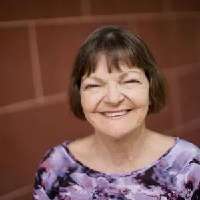Estimated read time: 5-6 minutes
- Chari Dickson and her sister Ashlyne Hatch underwent gastrectomies to prevent cancer.
- A gene mutation in their family causes aggressive cancerous polyp growth.
- Their mother and uncle died due to the mutation.
SALT LAKE CITY — The only stomach Chari Dickson has is about 8 inches tall, 6 inches wide, bright purple and has a cheerful applique face. She bought it on Amazon because it made her laugh.
Doctors at Huntsman Cancer Hospital removed the 36-year-old woman's real stomach less than two weeks ago, a preventive measure to spare her a painful, cancer-filled future death. A gene mutation has burned through her family, killing her mom, her grandfather and at least one uncle.
She is the latest family member to undergo a gastrectomy, where the entire stomach is removed and the esophagus connected directly to the small intestine. Her younger sister Ashlyne Hatch, 34, an uncle and her mom had similar surgeries, although for her mom it was about diminishing pain that she described as 100 on a scale of 1 to 10.
It was already too late to save Phelecia Hatch's life.
At least 20 people in Dickson and Hatch's immediate extended family have a SMAD4 gene mutation, which leads to unchecked cell growth and can cause cancer throughout the digestive tract. It's an autosomal dominant gene mutation, which means that if you have it, each of your children has a 50-50 chance of inheriting it. If you don't have it, you can't pass it on.
The numbers in this family are daunting.
Dickson and Hatch have an uncle whose children each have the mutation. Both of Dickson's children, who are 7 and 9, have it. Her daughter has already had polyps removed. Some people develop polyps in their colon, others in their stomach. Sometimes, the polyps are in both. They can be found and removed during colonoscopies and endoscopies that must be done frequently, but eventually there are simply too many to get them all, and even one left behind could turn into cancer.

Hatch had her first colonoscopy and endoscopy in her early 20s, and the mutation proved to be aggressive. Within a few years, she needed her stomach scraped every four months, and although none of the polyps were yet cancerous, she shouldn't have had them at all. Eventually, doctors told her she'd likely live better and longer without her stomach.
She took some time to consider it while she kept up on her screening schedule, she said. She had to mull it over and get used to the idea but opted to have the operation two years ago.
Dickson's last endoscopy before she decided to have a gastrectomy, too, found polyps growing so close together they formed what looked like a laminate floor, she said, noting sometimes SMAD4-related polyps are described as carpetlike because of their seemingly wall-to-wall coverage.

SMAD4 is fast-moving, and people are told to have their first colonoscopy 10 years younger than the age at which polyps were initially found in a parent. The advice is true for endoscopies, too — if someone is advised to have one at all.
And there's another complication that's possible with several gene mutations, including SMAD4. It's usually called HHT because its real name, hereditary hemorrhagic telangiectasia, is too hard to say or spell. That related condition creates abnormal blood vessels, among other issues. Nosebleeds can be so common and so severe that some people opt to have their nose sewn shut, she said. Her own nosebleeds, while persistent starting in childhood, have been much more mild.

Discovery of a mutation
Brent and Phelecia Hatch met at Pasadena City College in California, married and had seven children, a brood that includes four boys and another girl in addition to Ashlyne Hatch and Chari Dickson. The other five didn't inherit the mutation, which doesn't care about gender or birth order or other factors. The 50-50 chance is individual.
Phelecia Hatch knew that her dad died of colon cancer and, like a good health steward, she had regular colonoscopies. She didn't know she should also be having her esophagus and stomach scoped. That was something Dickson learned when she started having issues and had a genetic test that revealed SMAD4, which she researched very deeply. She tried to convince everyone in the family that having colonoscopies wasn't enough. But their doctors weren't telling them that, and for a long time, the advice was brushed off.
By the time Phelecia Hatch's cancer was found, it was Stage 4. She lived almost exactly three months, and her husband Brent Hatch thinks that she willed herself to make it so she could see her son get married. She died the same day. She was 54.
"The sad thing is, Chari two years previous sent her an email saying that you guys need to get an endoscopy, and she just kept getting colonoscopies because that's what her dad died of," Brent Hatch said.
Phelecia Hatch's brother Devin also died as a result of cancer from the SMAD4 mutation. The abnormal gene has exacted a very painful toll.

A different but 'doable' life
But on a sunny recent weekday in the Hatch family's Mapleton home, where Dickson sits beside Hatch hugging the stomach pillow tightly while she sips a protein drink, she and her sister chat cheerfully over the top of each other, finishing each other's sentences as they try to explain a medical challenge that has to some extent shaped their family life for years.
They can still eat, they explain, though it's different. Lack of a stomach messes some with hunger and satiety signals. They pick their food carefully for high protein and nutritional value, because food is fuel but the path through the esophagus is narrow and there's no holding tank waiting at the end. They limit how much sugar they consume because it increases gastric distress.










